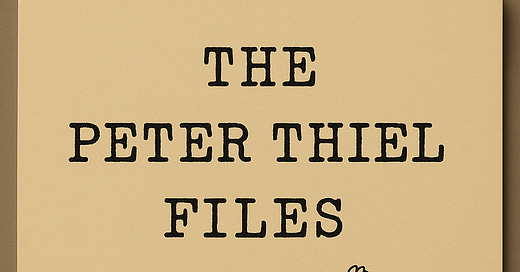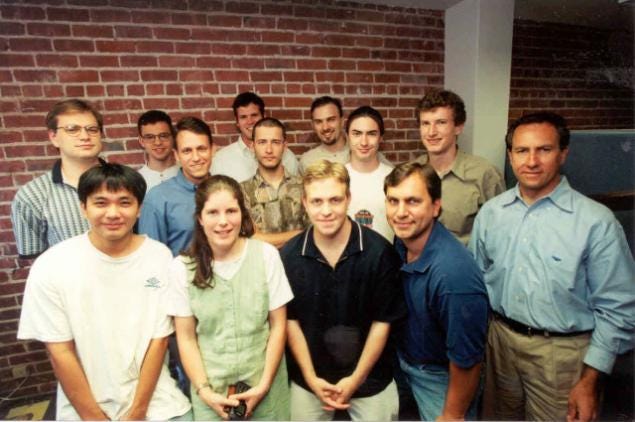The Peter Thiel Files, File II
Part two of a multi-part investigation into the ideology, influence, and empire of a man reshaping tech, politics, and power.
You can find part one of this series by clicking here. I highly recommend reading in order to understand the entire chronological picture.
So, these men? They were no longer just entrepreneurs. No, no.. They were architects. The PayPal Mafia had traded dorm room debates and dot-com dreams for something far more permanent.. control.
By the time eBay acquired PayPal in 2002 for $1,500,000,000 (1.5 billion), the first fifty employees had mostly scattered, but not far. They had each built something far more lasting than a payments platform.
They had built each other.
$1.5 billion in 2002 is equal to about $2.37 billion in 2025 when adjusted for inflation.
See, the early days of PayPal weren’t glamorous by any means. There were no kombucha taps or meditation pods. It didn’t look like the inside of a Buzzfeed office. The office was in a constant state of chaos. Turnover was constant. Questioning the mission got you pushed out. Loyalty, not morality, was the currency. Fraud was common. They faked user growth, gamed eBay’s platform, and spun manipulation into strategy all while Thiel was watching.
He didn’t want the best minds. He wanted the sharpest blades. People who wouldn’t flinch. People who would bend rules, rewrite systems, and never look back. PayPal wasn’t just a company. It was a initiation and those who thrived in it carried the playbook with them into the rest of Silicon Valley.
So, we all know how the story went from here. The very same people who learned to cheat the system went on to build the next one. They funneled what they learned (how to evade regulation, how to dominate markets, how to frame profit as progress) into the platforms that would define the digital age we use today.
They called it disruption. They called it innovation. What they were really doing was colonizing the public sphere one sector at a time. Education, healthcare, housing, elections. Nothing was off limits. If it could be privatized, it could be controlled and if it could be controlled, it could be shaped to their image.
David Sacks launched Yammer, later sold to Microsoft for $1.2 billion. Keith Rabois jumped into venture capital, backing surveillance startups and right-wing candidates with equal fervor. Reid Hoffman created LinkedIn, packaging personal data as professionalism.
And Peter? He co-founded Palantir, a data-mining firm so deeply embedded in government surveillance it blurred the line between Silicon Valley and the state.
A Machine That Predicts… You?
In 2003, Palantir Technologies was born. It was a name borrowed from Tolkien’s "seeing stones," which let their users spy across space and time. That wasn’t subtle. The company’s mission was surveillance, dressed up in the language of security and national defense.
At first, it was marketed as a tool to fight terrorism. This was just after 9/11, when the U.S. government was desperate for better surveillance and willing to throw money at anyone who promised it. Thiel said Palantir would stop bad guys while protecting civil liberties but that wasn’t the truth at all.
Palantir's first big investor wasn’t a tech company. It was the CIA. No seriously.
Through its venture capital arm, In-Q-Tel, the CIA gave Palantir millions to develop software that could dig through massive amounts of data: emails, phone calls, financial records, GPS logs, and even social media posts to find patterns.
In-Q-Tel is a company backed by the CIA that gives money to tech startups in in exchange for access to the tools those startups create.
Think of it like a digital dragnet. It scoops up as much data as possible, then uses algorithms to decide what matters. It does not just look at what you have done. It tries to guess what you might do next.
Palantir's main product is called Gotham. It is used by the CIA, the FBI, the military, and local police. It was designed for war zones like Afghanistan. But it is also used in American cities, often on people who have no idea they are being watched.
In 2014, Palantir signed a contract with ICE (Immigrations & Customs Enforcement). They helped build a system called Investigative Case Management, or ICM. It lets agents pull up a person’s entire life: immigration records, work history, family ties, travel, phone numbers, and link that person to others. If your roommate was flagged, you might be flagged too. The system creates webs of suspicion. It automates targeting.
Palantir claimed they were not involved in deportations. Internal documents showed that was false. Their system was marked as essential.
By 2024, Palantir made almost $3 billion a year and this continues to grow. About half of that came from government contracts. Your tax dollars at work.
It gets worse. Palantir isn’t just helping governments watch people. It’s helping them decide who to kill.
Next, Palantir built an artificial intelligence tool called AIP.
What’s that? Well.. It lets users ask an AI to plan military operations. The system can suggest airstrikes and troop movements. It was demonstrated in live war scenarios. Another project, called TITAN, is a mobile battlefield truck powered by AI. It helps commanders decide who to target and how.
Palantir is no longer just a software company. It is deeply embedded in governments, both in the United States and around the world. It handles intelligence, warfare, policing, immigration, public health, and more.
This is the future Thiel is helping build. Dystopian to say at the least.
World Domination
Palantir isn’t just selling to the U.S. government. Their reach is global.
In 2024, Palantir announced a formal partnership with the Israel Defense Forces (IDF). They now provide surveillance and intelligence systems directly to the IDF to support what they call "war-related missions."
In plain language, this means predictive policing, AI-assisted targeting, and battlefield analytics in the middle of a brutal “war” that has killed hundreds of thousands of innocents. Their dystopian ideas were no longer theoretical. Palantir is involved in live conflicts, shaping who lives and who dies, while pretending it’s just “data infrastructure.”
Protesters were furious & had surrounded Palantir’s London office in response. Their signs called out the company and their complicity in war crimes. Meanwhile, CEO Alex Karp doubled down. He said more tech companies should be helping Israel even going as far to rebuke those who don’t. They framed it as defending “Western values.”
What they meant was protecting power. He said Palantir stands proudly behind its work. Employees who disagreed? They left the company.
Remember what we said earlier. Over half of Palantir’s revenue comes from government contracts. Its first funding came from the CIA. Its software is deployed by the Department of Defense, ICE, the CDC, and dozens of federal agencies.
So when Palantir signs a military partnership with Israel, that isn’t just a private deal. That’s an extension of U.S. foreign policy. A data pipeline backed by American capital, American tax dollars, American tech, and American silence.
Thiel’s vision is playing out in the blood of dead children, not just code.
“I no longer believe that freedom and democracy are compatible.”
—Peter Thiel, 2009
Palantir was never just a company. It was a vessel. A delivery system for a political vision and that vision is not democratic.
It was shaped quietly, deliberately by someone even less well-known than Thiel. A man who does not run a company, but whose fingerprints are all over the ideology behind the empire.
Curtis Yarvin
The very man Peter Thiel calls a friend, a collaborator, and sometimes, his coach. The father of “tech-bro autocracy.”
Truly, if Peter Thiel has ever felt something close to love, if he has ever experienced anything resembling human attachment, it would be for this man. Thiel is not sentimental. He does not form emotional bonds. He forms alliances. He collects minds like weapons and Curtis Yarvin was exactly the kind of weapon he wanted.
It almost feels like a supervillain league at this point.
Yarvin spent years hiding behind a screen name, calling himself Mencius Moldbug, publishing unhinged manifestos about monarchy, race, and the collapse of democracy. The kind of writing that should have stayed buried in internet backwaters. Deranged. Rambling. Deeply cruel.
But Peter read it. And more importantly, he somehow understood it. He agreed. It wasn’t too far off from his work, if you can call it that, at Stanford after all.
So, Yarvin believes democracy is not just broken, but illegitimate. He wants it replaced with a corporate monarchy, run by an unelected ruler chosen by wealthy “shareholders.”
He says Americans need to get over their “dictator phobia.”
Wait a minute. Is this real life, or did we all wake up inside the 2012 cinematic masterpiece The Dictator?
Back to Yarvin. Yarvin wants to dissolve Congress, shut down universities, and replace the free press with executive control. He has defended slavery, suggested that some races are biologically suited to servitude, and claimed civil rights protections created “absolute human garbage.”
This is the man who shaped Peter Thiel’s worldview. This is the man Thiel funds, quotes, and promotes.
Picture a sack of decomposing meat sweating under a Texas heat dome.. That’s Curtis Yarvin, but with a blog.
Thiel also loves to put his money to evil causes. He was a major financial backer in Yarvin's tech ventures, including a $250,000 investment in Yarvin's company, Tlon. It aims to replace the current internet with a decentralized, privately owned system where users run their own personal servers and hierarchy is hardcoded into the architecture.
Sadly, the roots of these belief systems go even deeper.
If you remember from part one, that back at Stanford, Thiel became obsessed with the Leo Strauss. Strauss taught that most people could not handle the truth, and that real power should be held by a small, wise elite who understood the world’s darker realities. That the truth should be hidden behind careful lies. That a philosopher-king should rule in silence.
Yarvin took those ideas and stripped away the subtlety. He turned them into doctrine. He replaced the philosopher-king with a CEO. He wrapped it all in Silicon Valley arrogance and called it modern.
Strauss told his students that the masses needed myth. Yarvin told them they needed chains. Peter adored the ideas tof both.
Yarvin calls his ideology the Dark Enlightenment. Thiel calls it the future. Sadly, we may actually be closer to that Corporate Monarchy that than most people realize. In 2025, it is not just some toxic internet philosophy. It is now embedded inside the highest levels of American power.
Vice President JD Vance has cited Yarvin by name. He called his writing “interesting,” which is how men like Vance say, “I agree, but I’m pretending not to.” He praised Yarvin’s plan to dismantle the civil service.
Do you know who else dismantled the civil service, and replaced them with loyalists? Yep, that’s right.. Adolf Hitler in 1933, who enacted the Law for the Restoration of the Professional Civil Service to purge Jews and political opponents from government positions. Yikes.
Vance even used Yarvin’s exact phrase for the plan: RAGE: Retire All Government Employees. He said, out loud, that Trump should fire every career bureaucrat, replace them with loyalists, and if the courts try to stop him? Ignore the courts.
Now, I want you to take a second before you continue reading to reflect on what the last six months have looked like in the United States.
The mass exodus of federal employee’s under Elon Musk’s DOGE in the name of ‘efficiency’, federal employees being given loyalty tests, federal judges being attacked by the president daily, court orders being treated as suggestions, and SCOTUS orders being actively ignored. Now, think about that in conjunction to what you’ve read in this article today. It starts to make sense.
Now, just know that none of it would have happened without Peter Thiel.
Thiel bankrolled JD Vance’s Senate campaign. As of 2025, Peter Thiel has given at least $15.2 million to support JD Vance’s political career. He helped write the script. He opened the doors. He took an angry, floundering author from Ohio with a love of couches, and turned him into a Trojan horse for his ideology. A smiling front-man for a bloodless coup.











This makes me want to vomit even more.
Substack is a privately held company founded in 2017 by Chris Best (CEO), Hamish McKenzie, and Jairaj Sethi. The platform enables writers to publish and monetize subscription-based newsletters, podcasts, and videos.  
Ownership and Investors
While the founders maintain significant control, Substack has raised approximately $89.5 million through multiple funding rounds. Notable investors include: 
• Andreessen Horowitz (a16z): Led both the Series A and Series B funding rounds.
• Y Combinator: Substack was part of Y Combinator’s Winter 2018 batch. 
• Naval Ravikant: Co-founder of AngelList and a prominent angel investor. 
• Omeed Malik: Founder of 1789 Capital, a fund investing in media ventures. 
• Nate Silver: Statistician and founder of FiveThirtyEight. 
In 2023, Substack initiated a community fundraising round, allowing writers on the platform to invest in the company. 
Peter Thiel’s Involvement
There is no public record indicating that Peter Thiel has invested in Substack. While Thiel is known for supporting platforms that emphasize free speech, such as Rumble and Palantir, his involvement with Substack has not been reported.
Platform Philosophy
Substack positions itself as a platform that champions free expression, offering minimal content moderation compared to traditional media outlets. This approach has attracted writers across the political spectrum, including those who have departed from mainstream media. 
In summary, Substack remains an independent company with a diverse group of investors. There is no evidence to suggest that Peter Thiel has any ownership stake or direct influence over the platform.